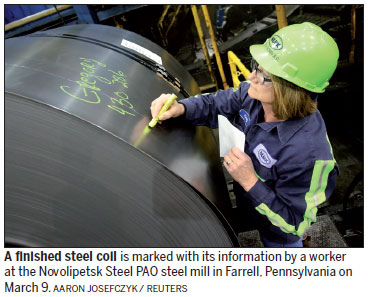
Prices of US-made steel and aluminum have been rising since US President Donald Trump said he would impose tariffs on the two metals, and the price increases may reflect other factors, industry observers said.
Earlier this month Trump pressed ahead with import tariffs of 10 percent on aluminum and 25 percent for steel that are scheduled to take effect on Friday. The president exempted Canada and Mexico and suggested he might exclude other allies, apparently backtracking from an earlier “no-exceptions” stance.
Joseph Innace, content director for America’s Metals at S&P Global Platts, said the price of US-made hot-rolled steel coil, considered a benchmark bellwether product, was at $852 per short ton on Friday.
“The price was $630 per short ton on January 20, 2017, which is the day Trump was inaugurated,” Innace said in an interview Monday.
While the 35 percent increase was driven in part by the expectation of tariffs within the industry, Innace said the main driver has been the fundamental demand factors that affect steel prices.
“Prices were on the rise before the tariffs. Construction, energy and autos have been strong for over a year now,” Innace said, noting that those industries push demand for steel in the US.
To gauge what may happen to steel prices in six months if the tariffs are imposed, Innace studied steel prices in the time after then-US president George W. Bush implemented steel tariffs in March 2002.
Innace said prices for steel were at a 20-year low when Bush imposed tariffs, but are at a seven-year high now.
Steel prices rose 47 percent from April to July of 2002, Innace said. “I don’t think prices will escalate that much now,” he added, because much of the increase from the expectation of tariffs has already been “baked in.”
Aluminum prices in the US have been increasing since the beginning of the year according to Karen McwBeth, content director of metals pricing for S&P Global Platts
Since Jan 2, McBeth said aluminum prices have jumped from about 9.5 cents per pound to 20 cents a pound on Friday.
McBeth believes that a majority of that increase was due to the expectation of tariffs. As for the future of aluminum prices, McBeth said to look to the futures market.
“Aluminum has an active futures market, more so than steel,” she said in an interview. “Currently, some forward numbers for April and May trade at 16.5 cents (per pound), and June traded at just under 16 cents.”
One factor that could be contributing to that is the proposed exemption for Canada, which supplies most of the aluminum to the US, McBeth said.


